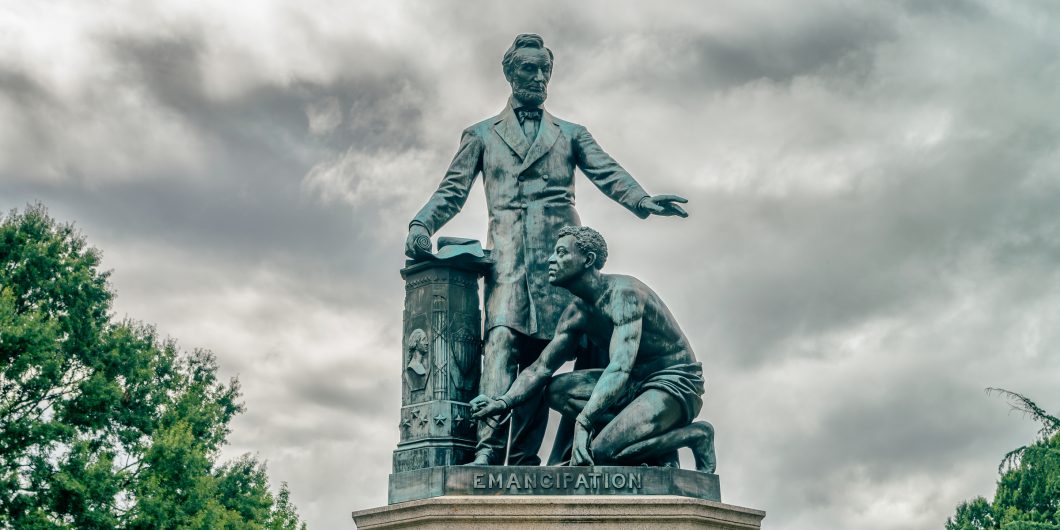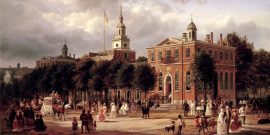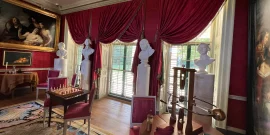Willmoore Kendall argued that America can retain its virtue only through a culture articulated and upheld by the institutions of civil society.
Radicalized Political Ingratitude
On February 25, a New York Times front-page story exposed a specious incident of alleged racial harassment at Smith College. In July 2018, Oumou Kanoute, a black student who had grown up in Manhattan but whose parents came from Mali, claimed to have experienced a near-“meltdown” because both a janitor and a campus police officer asked what she was doing in a dormitory lounge as she lunched there. She viewed their interruption of her meal as an “outrageous” sign that some Smith personnel questioned her presence at the College, and indeed her very “existence overall as a woman of color.” She also disclosed her terror at the possibility that the police officer might have been carrying “a lethal weapon.”
Not surprisingly, given the recent political environment on American campuses, Smith’s president Kathleen McCartney immediately issued an apology for the incident and put the janitor on paid leave, remarking—prior to any investigation—that the incident served as a painful reminder of “the ongoing legacy of racism and bias … in which people of color are targeted while simply going about their daily business.”
As the Times recounts, a report issued three months later by a law firm hired by Smith to investigate the episode drew little attention. This report found no evidence of bias, and instead determined that Ms. Kanoute had been eating in a dorm that was closed for the summer. The janitor had been encouraged to notify campus security if he saw any unauthorized people there, and the security officer who followed up on the report was (like all Smith College police) unarmed.
In the meantime, Jackie Blair, a veteran cafeteria employee who had reminded Kanoute that students weren’t allowed to be eating in the vacant room, was targeted by Kanoute on Facebook as a “racist,” along with a janitor who’d been employed at Smith for 21 years and wasn’t even on campus at the time of the incident. Blair, who received threatening notes and phone calls as a consequence of the accusation, had to be hospitalized when the threats generated an outbreak of her lupus. The janitor resigned his position after Kanoute posted his photo on social media, charging him with “racist cowardly behavior.”
The 2018 incident recently returned to the headlines thanks to a letter of resignation issued by Jodi Shaw, a former student support coordinator at Smith, in response to the lasting effect that the College administration’s treatment of the Kanoute affair and its offshoots had on the Smith community, and on her job in particular. Having been told in August of 2018, for instance, that she had to cancel a long-planned library orientation program because she had put it in the form of a rap, and her whiteness made the event a form of cultural appropriation, she ultimately had had to withdraw her candidacy for a full-time position at the library and settle into a lower-paying job in Residence Life.
In that position, Shaw (a 1993 Smith graduate) found herself repeatedly instructed that she would be required to discuss her thoughts and feelings about her skin color and endure racially hostile comments. For example, Shaw recounted a meeting in which another staff member banged a table while denouncing Smith alumnae as “rich white women.” Although Smith undoubtedly relies heavily for its sustenance on such alumnae, Shaw herself, a single mother of two young children, was earning $45,000 annually, considerably less than the cost of a year’s room, board, and tuition at the school.
What is particularly noteworthy is the contrast between Kanoute’s background and that of the Smith employees whose careers she ruined. Each of the latter were individuals of modest economic (and except for Shaw, educational) status. By contrast, while the country from which Kanoute’s parents emigrated is one of the world’s very poorest and worst-governed, Kanoute herself, prior to enrolling at Smith with liberal financial aid, graduated from the prestigious Westminster School in Simsbury, Connecticut, where room, board, and tuition run some $70,000 per year.
Yet Kanoute, far from exhibiting gratitude, as the offspring of immigrants from an oppressive and impoverished nation, for the blessings that American citizenship affords, instead has devoted her energies to denouncing America for its racism. We shouldn’t be surprised that prior to her scheduled 2021 graduation, Kanoute has already obtained employment as a “research assistant-intern” at Columbia University’s School of Social Work, in a “lab” that “focuses on innovative ways to conceptualize and measure racism.”
Kanoute’s story is only a single instance of a broader phenomenon I am terming “racialized political ingratitude,” one that has recently been exhibited on a grander scale by the news that Eleanor Holmes Norton, now serving her 15th term as nonvoting Representative to the U.S. Congress from the District of Columbia, has reintroduced her 2020 legislative proposal to tear down or otherwise remove Washington’s Freedmen’s Monument, whose fabrication was entirely financed by former slaves in 1876, and which was dedicated by the great ex-slave, abolitionist, civil rights leader, and diplomat Frederick Douglass in one of his most celebrated orations. Norton observes that Douglass himself, while applauding the ex-slaves’ demonstration of gratitude to the Great Emancipator in his address, not only avoided praising the statue, but subsequently complained in a letter that its design “showed the negro on his knee when a more manly attitude would have been more indicative of [his] freedom.”
Douglass warned his fellow black citizens, “Tear the statue down and we have testified, in art and in society, that we now believe that we live only as creatures of blood and impulse, slaves to the past, not free men and women.”
Norton directly contradicts the chief significance that Douglass attributed to the Freedmen’s Monument: that by honoring the memory of their “friend and liberator” Lincoln, African-Americans had refuted forever the “reproach of ingratitude” for the good they had received from their benefactors. Douglass himself, as an escaped slave, had reproached his fellow free blacks prior to the Civil War for not doing as much as they should for the abolition cause and for self-improvement. He observed, “we despise a freedom and equality obtained for us by others, and for which we have been unwilling to labor.” However, he was far too realistic a statesman to have believed that black Americans themselves could have destroyed the institution of slavery chiefly by their own efforts—and far too honest not to appreciate and acknowledge how much ex-slaves owed to Lincoln for the work of emancipation.
Douglass’s public celebration of Lincoln’s achievement and of the significance of the Freedmen’s Monument far outweighs the complaints he subsequently voiced about its design. Moreover, as the distinguished historians Allen Guelzo and James Hankins observe in their illuminating essay “Of, by, and for the Freedmen,” a decade later, Douglass effectively retracted those complaints, as well as any reservations he had expressed about Lincoln’s leadership. He remarked that “In all my interviews with Mr. Lincoln I was impressed with his entire freedom from popular prejudice against the colored race,” and that Lincoln “was the first great man that I talked with in the United States freely, who in no single instance reminded me of the difference between himself and myself, of the difference of color.” He warned his fellow black citizens, “Tear the statue down and we have testified, in art and in society, that we now believe that we live only as creatures of blood and impulse, slaves to the past, not free men and women.”
The story of the monument’s design itself is far more complex and nuanced than Rep. Norton would have it. As Guelzo and Hankins observe, although the sculptor, Thomas Ball, was white—there being no established black sculptors in the 1860s and ’70s when the monument was constructed—not only did
the original impulse for the work came from a freedwoman, Charlotte Scott; the statue was entirely funded by the contributions of former slaves; the design of the statue was thoroughly revised in response to African-American sentiment; and the celebrations for the unveiling of the statue in 1876 were almost entirely the work of Washington D.C.’s African-American community. No work of American sculpture in the nineteenth century, in fact, was more the product of collective African-American agency than the Freedman’s Memorial.
Guelzo and Hankins recount in generous detail how the statue’s design evolved precisely to avoid giving any impression of servility on the emancipated slave’s part. Whereas the original bronze model depicted a slave boy, not a man, “in a passive, almost dreamlike state, which made Lincoln appear to be casting some kind of spell over him” (in an adaptation of a well-known neoclassical statue), the commissioners who oversaw the project “insisted that Ball redesign the freedman as an older, more powerful and independent figure.”
In consequence, “the new bronze, almost three times the size of the previous model,” shows “a muscular, semi-nude black male in the act of rising to his feet,” not passive, but rather acting on his own “to break the chain that had bound him.” And rather than merely removing the slave’s bonds, “Lincoln’s left arm is held out in a welcoming gesture, as though to clasp the young man by the shoulder as he rises.” Additionally, if the freed slave had been fully erect, his height would have rivaled that of the 6’4” Lincoln. As Guelzo and Hankins put it, though the ex-slave’s “wrists still wear the shackles that had but recently been attached to chains; his right fist is clenched, the left falls by his side in a relaxed gesture. His head is held high, and there is a determined, hopeful expression on his face.”
As for Lincoln’s place in the monument, as Guelzo and Hankins observe, although he “stands, he does not rule. The young man is moving upwards on his own accord, and his gaze is directed somewhere far beyond Lincoln or any cues Lincoln might be thought to be giving. In another revision to the 1865 design, Lincoln seems to stand back with one foot, as though in mingled amazement and appreciation of this new apparition, a free black man.”
There is much more to Guelzo and Hankins’s analysis of the Freedmen’s Monument, which I commend to readers. But Representative Norton and her supporters evince no interest in any such analysis, any more than Oumou Kanoute has shown in advancing understanding between the races in today’s America. Gratitude for the privileges that American citizenship bestows, and for those who made those privileges and their extension possible (including the Founders, Lincoln, Douglass, and numerous others whose statues have recently been toppled, or names removed from public buildings) is in all too short supply today.
So is intellectual honesty, or elemental historical awareness, when it comes to this country’s past. In 2020, vandals even tore down the statue of Douglass in Rochester, New York. They also defaced the monument in Boston Common to Colonel Robert Gould Shaw and the all-black Massachusetts 54th Volunteer Infantry Regiment. This unit suffered heavy casualties at the siege of Fort Wagner (with Col. Shaw among the fallen)—and inspired the enlistment of nearly 200,000 African-Americans into the Union Army.
More than ever, America needs educators, statesmen, and citizens who will endeavor to remedy these intellectual and moral deficiencies.



